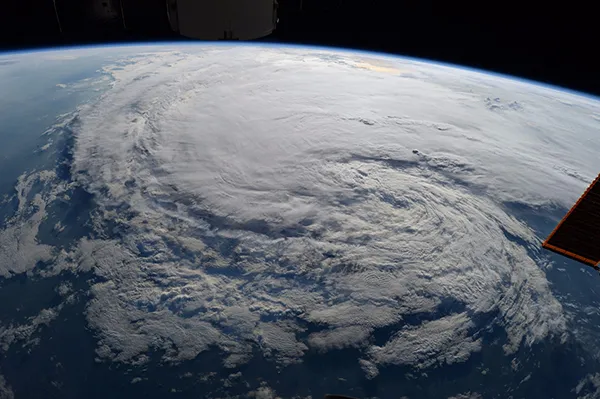Hurricanes and Climate Change
In 2017, Hurricane Harvey decimated the Texas coast around Houston, causing catastrophic flooding due to a record amount of rain. Harvey, which came ashore as a strong Category 4 storm, weakened and then stalled. Over four days, as the storm wandered along the coast, many areas received more than 40 inches of rain (and some got up to 60 inches) causing major flooding, causing over a hundred billion dollars in damage, and displacing more than 30,000 people.

Hurricane Harvey as seen from the International Space Station in September 2017.
NASA
Hurricane Harvey was very unusual but will we see more unusual hurricanes as the climate continues to change? The answer is yes!
Thanks to improved hurricane models and use of dropsonde technology, we know a lot about how human-caused climate change is affecting hurricanes and tropical storms now, and how it will likely affect them in the future.
More Precipitation
A hurricane’s ability to produce rain is affected by the temperature of the air and ocean water. Warm air can hold more moisture; more moisture often leads to more rain. That’s how climate change causes wetter storms. Researchers studying Hurricane Harvey found that human-induced climate change made extreme rainfall more likely. In general, models show hurricane rainfall increasing by 10 to 15 percent on average by the end of the century. That means that we may see more storms like Harvey.
Stronger Winds
There’s evidence that over this century anthropogenic climate change will cause more intense tropical cyclones globally. Hurricane intensity is characterized by the strength of a storm’s winds.
Warmer water causes hurricanes and tropical storms to become more intense, with faster wind speeds. The storms draw energy from warm ocean water which can cause a weak storm with moderate winds to intensify into a strong and destructive storm. For example, Harvey had weakened to a tropical storm before it encountered warm water in the Gulf of Mexico and strengthened to a Category 4 storm.
Sea surface temperature rose an average of 0.88 °C (1.5 °F) between 1900 and 2020, and the tropical sea surface has warmed faster than the global average. During this century, the temperature of the sea surface is projected to warm even faster, which will fuel stronger hurricanes in the tropics. While the number of hurricanes might remain the same, scientists predict that Category 4 and 5 hurricanes will be more common by the end of the century.
Sea Level Rise and Vulnerability
Forty percent of the US population lives in coastal communities putting many people directly in harm’s way because of rising seas and stronger hurricanes. According to the 2023 report by the Intergovernmental Panel on Climate Change (IPCC), sea level is predicted to rise between 29 and 110 centimeters (about one to four feet) by 2100 as a warmer planet causes thermal expansion of the seas and melting glaciers and ice sheets. Sea level rise will make storm surge flooding during hurricanes more devastating.
If the global climate keeps warming, hurricanes are likely to be more intense and potentially more destructive. Storm surges and intense rainfall will cause more flooding. Storms like Hurricane Harvey in 2017 may seem less like unusually catastrophic anomalies and more like the new normal.
© 2024 UCAR